In 2026, the Peruvian economy will grow by 3.2%, a pace similar to that of 2025, despite electoral risks
In the third quarter of 2025, the economy grew by 2.5%, a slower pace than that observed in the first months of the year.
In the third quarter of 2025, the economy grew by 2.5%, a slower pace than that observed in the first months of the year.
This month, President Dina Boluarte’s cabinet demonstrated resilience in the face of criticism over leaked audio recordings implicating Ministers Eduardo Arana (PCM) and Juan José Santiváñez (Interior).
The Government’s main allies, Fuerza Popular and APP, leveraged the crisis triggered by the murder of 13 mine workers in Pataz to strengthen their influence over ministerial appointments.

